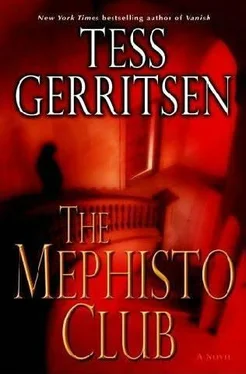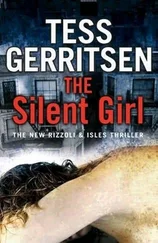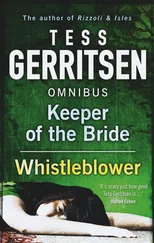“It could have been frozen,” said Marquette.
“No,” said Jane. “There’s no cellular damage under the microscope. That’s what Dr. Isles said. When you freeze tissue, the expansion of water ruptures cells, and she didn’t find that. The hand may have been refrigerated, or packed in ice water, like they do to transport harvested organs. But it wasn’t frozen. So we think the owner of that hand was probably killed no more than a few days ago.”
“If she was killed,” said Zucker.
They all stared at him. The terrible implication of his words made them all pause.
“You think she could still be alive ?” said Frost.
“Amputations in and of themselves aren’t fatal.”
“Oh, man,” said Frost. “Cut off her hand without killing her…”
Zucker flipped through the rest of the autopsy photos, pausing over each one with the concentration of a jeweler peering through his loupe. At last he set them down. “There are two possible reasons why a killer would cut up a body. The first is purely practical. He needs to dispose of it. These are killers who are self-aware and goal-directed. They understand the need to dispose of forensic evidence and hide their crimes.”
“Organized killers,” said Frost.
“If dismemberment is followed by the scattering or concealment of body parts, that would imply planning. A cognitive killer.”
“These parts weren’t in any way concealed,” said Jane. “They were left around the house, in places where he knew they’d be found.” She handed another stack of photos to Zucker. “Those are from the crime scene.”
He opened the folder and paused, staring at the first image. “This gets even more interesting,” he murmured.
He looks at a severed hand on a dinner plate, and that’s the word that comes to mind?
“Who set the table?” He looked up at her. “Who laid out the dishes, the silverware, the wineglasses?”
“We believe the perp did.”
“Why?”
“Who the hell knows why?”
“I mean, why do you assume he was the one who did it?”
“Because there was a smear of blood under one of the plates, where he handled it.”
“Fingerprints?”
“Unfortunately, no. He wore gloves.”
“Evidence of advance planning. Forethought.” Zucker directed his gaze, once again, at the photo. “This is a setting for four. Is that significant?”
“Your guess is as good as ours. There were eight plates in the cabinet, so he could have put down more. But he chose to use only four.”
Lieutenant Marquette asked, “What do you think we’re dealing with here, Dr. Zucker?”
The psychologist didn’t answer. He paged slowly through the photos, pausing at the image of the severed arm in the bathtub. Then he flipped to the photo of the kitchen, and he stopped. There was a very long silence as he stared at the melted candles, at the circle drawn on the floor. At what sat at the center of that circle.
“It looked like some kind of a weird ritual setup to us,” said Frost. “The chalk circle, the burned candles.”
“This certainly appears ritualistic.” Zucker looked up, and the glitter in his eyes made a chill wash up the back of Jane’s neck. “Did the perp draw this circle?”
Jane hesitated, startled by his question. “You mean-as opposed to the victim?”
“I’m not making any assumptions here. I hope you don’t either. What makes you so certain the victim didn’t draw this circle? That she didn’t start off as a willing participant in the ritual?”
Jane felt like laughing. Yeah, I’d volunteer to get my head cut off, too. She said, “It had to be the killer who drew that circle and lit those candles. Because we found no pieces of chalk in the house. After he used it to draw on that kitchen floor, he took it with him.”
Zucker leaned back in his chair, thinking. “So this killer dismembers, but doesn’t conceal the body parts. He doesn’t disfigure the face. He leaves little in the way of forensic evidence, indicating an awareness of law enforcement. Yet he hands us-so to speak-the biggest clue of all: the body part of another victim.” He paused. “Was there semen left behind?”
“None was detected in the victim’s body.”
“And the crime scene?”
“CSU went all over that house with UV. The CrimeScope picked up hairs too numerous to count, but no semen.”
“Again, characteristic of cognitive behavior. He leaves no evidence of sexual activity. If he is indeed a sexual killer, then he’s controlled enough to wait until it’s safe to enjoy his release.”
“And if he’s not a sexual killer?” asked Marquette.
“Then I’m not entirely sure what all of this represents,” said Zucker. “But the dismemberment, the display of body parts. The candles, the chalk circle.” He looked around the table. “I’m sure we’re all thinking the same thing. Satanic rituals.”
“It was Christmas Eve,” added Marquette. “The holiest of nights.”
“And our killer isn’t there to honor the Prince of Peace,” said Zucker. “No, he’s trying to summon the Prince of Darkness.”
“There’s one other photo you should look at,” said Jane, pointing to the stack of images that Zucker hadn’t yet seen. “There was some writing, left on the wall. Drawn in the victim’s blood.”
Zucker found the photo. “Three upside-down crosses,” he said. “These could well have satanic meanings. But what are these symbols beneath the crosses?”
“It’s a word.”
“I don’t see it.”
“It’s a reverse image. You can read it if you hold it up to a mirror.”
Zucker’s eyebrow lifted. “You do know, don’t you, the significance of mirror writing?”
“No. What’s the significance?”
“When the Devil makes a deal to buy your soul, the pact is drawn up and signed in mirror writing.” He frowned at the word. “So what does it say?”
“ Peccavi. It’s Latin. It means: ‘I have sinned.’”
“A confession?” suggested Marquette.
“Or a boast,” said Zucker. “Announcing to Satan, ‘I’ve done your bidding, Master.’” He gazed at all the photos laid out on the table. “I would love to get this killer into an interview room. There’s so much symbolism here. Why did he arrange the body parts in just this way? What’s the meaning of the hand on the plate? The four place settings on the dining table?”
“The Four Horsemen of the Apocalypse,” Detective Kassovitz said softly. It was one of the few times she’d spoken during the meeting.
“Why do you suggest that?” asked Zucker.
“We’re talking about Satan. About sin.” Kassovitz cleared her throat, seemed to gain her voice as she sat straighter. “These are biblical themes.”
“The four place settings could also mean he has three invisible friends who are joining him for a midnight snack,” said Jane.
“You don’t buy into the biblical theme?” said Zucker.
“I know it looks like Satanism,” said Jane. “I mean, we’ve got it all here-the circle and the candles. The mirror writing, the upside down crosses. It’s like we’re supposed to come to that conclusion.”
“You think it was merely staged this way?”
“Maybe to hide the real reason Lori-Ann Tucker was killed.”
“What motives would there be? Did she have romantic problems?”
“She’s divorced, but her ex-husband lives in New Mexico. They apparently had an amicable parting. She moved to Boston only three months ago. There seem to be no boyfriends.”
“She had a job?”
Eve Kassovitz said, “I interviewed her supervisor over at the Science Museum. Lori-Ann worked in the gift shop. No one knew of any conflicts or any problems.”
Читать дальше












